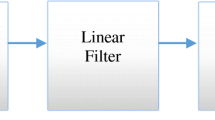Abstract
In this paper, we present a new morphology-based homomorphic filtering technique for feature enhancement in medical images. The proposed method is based on decomposing an image into morphological subbands. The homomorphic filtering is performed using the morphological subbands. The differential evolution algorithm is applied to find an optimal gain and structuring element for each subband. Simulations show that the proposed filter improves the contrast of the features in medical images.
Similar content being viewed by others
References
A. Laine, J. Fan, and W. Yang, “Wavelets for contrast enhancement of digital mammography,” IEEE Eng. Med. & Biol. Mag., vol. 145, pp. 536–550, 1995.
H. Oktem, K. Egiazarian, J. Niittylahti, and J. Lemmetti, “An approach to adaptive enhancement of diagnostic x-ray images,” EURASIP J. Applied Signal Processing, vol. 2003, pp. 430–436, 2003.
J. H. Yoon and Y. M. Ro, “Enhancement of the contrast in mammographic images using the homomorphic filter method,” IEICE Trans. Inf. & Syst., vol. E85-D, no. 1, pp. 298–303, Jan. 2002.
H. I. Ashiba, K. H. Awadallah, S. M. El-Halfawy, and F. E. El-Samie, “Homomorphic enhancement of infrared images using the additive wavelet transform,” Progress in Electromagnetics Research C, vol. 1, pp. 123–130, 2008.
P. Maragos, “Morphological filtering for image enhancement and feature detection,” in The Image and Video Processing Handbook, ed. A.C. Bovik, 2nd ed., pp. 135–156, Elsevier Academic Press, 2005.
N. Harvey and S. Marshall, “The use of genetic algorithms in morphological filter design,” Elsevier Signal Processing: Image Communication, vol. 8, no. 1, pp. 55–72, 1996.
M. Paulinas and A. Usinskas, “A survey of genetic algorithms applications for image enhancement and segmentation,” Inform. Tech. & Control, vol. 36, no. 3, pp. 278–284, 2007.
R. Storn, “Differential evolution, a simple and efficient heuristic strategy for global optimization over continuous spaces,” Journal of Global Optimization, vol. 11, no. 4, pp. 341–359, Dec. 1997.
P. Thomas and D. Vernon, “Image registration by differential evolution,” Proc. of the Irish Machine Vision & Image Processing Confer., pp. 221–225, 1997.
S. Rahnamayan, H. R. Tizhoosh, and M. M. A. Salama, “Image thresholding using differential evolution,” Proc. of Inter. Confer. on Image Processing, Computer Vision & Pattern Recognition, pp. 244–249, Jun. 2006.
M. Watanabe, T. Endoh, M. Shiohara, and S. Sasaki, “Palm vein authentication technology and its applications,” Proc. of the Biometric Consortium Confer., pp.37–38, Sep. 2005.
V. Paquit, J. R. Price, R. Seulin, F. Meriaudeau, R. H. Farahi, K. W. Tobin, and T. L. Ferrell, “Nearinfrared imaging and structured light ranging for automatic catheter insertion,” in Medical Imaging 2006: Visualization, Image-Guided Procedures & Display, ed. K. R. Cleary, R. L. Galloway, and Jr., SPIE 6141, pp. 61411T-1–61411T-9, SPIE, 2006.
J. C. Yang and D. S. Park, “Fingerprint verification based on invariant moment features and nonlinear BPNN,” International Journal of Control, Automation, and Systems, vol. 6, no. 6, pp. 800–808, 2008.
Author information
Authors and Affiliations
Corresponding author
Additional information
Recommended by Editorial Board member Sung-Kwun Oh under the direction of Editor Young-Hoon Joo.
Jinsung Oh received his B.S. and M.S. degrees in Electrical Engineering from Yonsei University, Korea in 1987, 1989, and his Ph.D. degree in Electrical Engineering at University of Pittsburgh, U.S.A. in 1998. He is an assistant professor in Department of Electrical Engineering at Halla University, Korea. His research interests include image processing, architecture and algorithms for multimedia systems.
Heesoo Hwang received his B.S., M.S., and Ph.D. degrees in Electrical Engineering from Yonsei University in 1986, 1988 and 1993, respectively. From 1993 to 2000 he worked for system engineering of Korea High-Speed Rail Development project as a senior and a principal researcher in KRRI and KHSR, respectively. Since 2001 he is an associate professor in Department of Electrical Engineering at Halla University. His research interests include pattern classification, event prediction, and surveillance using fuzzy logic, neural network, and evolutionary algorithms.
Rights and permissions
About this article
Cite this article
Oh, J., Hwang, H. Feature enhancement of medical images using morphology-based homomorphic filter and differential evolution algorithm. Int. J. Control Autom. Syst. 8, 857–861 (2010). https://doi.org/10.1007/s12555-010-0418-y
Received:
Accepted:
Published:
Issue Date:
DOI: https://doi.org/10.1007/s12555-010-0418-y




